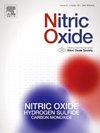硫化氢催化no -铁血红素形成的作用。
IF 3.2
2区 生物学
Q2 BIOCHEMISTRY & MOLECULAR BIOLOGY
引用次数: 0
摘要
我们最近证明了在还原谷胱甘肽(GSH)或其他小硫醇存在的情况下,不稳定的铁血红素和一氧化氮(NO)之间的快速反应,这一过程被称为硫醇催化的还原性亚硝基化,产生一种新的信号分子,不稳定的亚硝基铁血红素(NO-铁血红素),我们和其他人已经证明它可以调节血管舒张和血小板稳态。红细胞(RBC)含有高浓度的谷胱甘肽,并且NO可以通过亚硝酸盐还原和/或红细胞内皮一氧化氮合酶(eNOS)在红细胞中生成,因此NO-铁血红素原则上可以在红细胞中形成。no -铁血红素也可以在其他细胞和区室中形成,包括在血浆中,其中也存在另一种小而活性的硫醇物质硫化氢(H2S/HS-),并可能催化no -铁血红素的形成,类似于谷胱甘肽。在这里,我们比较了谷胱甘肽和硫化氢与血红蛋白在生理相关介质中的反应性,包括人血清白蛋白(HSA)和红细胞膜。引人注目的是,硫化氢的二级速率常数比谷胱甘肽高10倍以上。我们认为H2S对谷胱甘肽在亲脂环境中的溶解度增加——在亲脂环境中最容易找到不稳定的血红素——以及体积较大的谷胱甘肽的空间位阻增加,解释了与硫化氢观察到的更快的反应动力学。我们的研究结果表明,硫化氢催化的还原性亚硝基化反应产生亚硫亚酸(HSNO),该反应很容易与过量的硫化氢进一步反应形成亚硝基硫化物(SSNO-)和多硫化物。这些结果表明,巯基催化的不稳定铁血红素的还原亚硝基化可能在NO信号传导中发挥重要作用。本文章由计算机程序翻译,如有差异,请以英文原文为准。
Role of hydrogen sulfide in catalyzing the formation of NO-ferroheme
We recently demonstrated a rapid reaction between labile ferric heme and nitric oxide (NO) in the presence of reduced glutathione (GSH) or other small thiols in a process called thiol-catalyzed reductive nitrosylation, yielding a novel signaling molecule, labile nitrosyl ferrous heme (NO-ferroheme), which we and others have shown can regulate vasodilation and platelet homeostasis. Red blood cells (RBCs) contain high concentrations of GSH, and NO can be generated in the RBC via nitrite reduction and/or RBC endothelial nitric oxide synthase (eNOS) so that NO-ferroheme could, in principle, be formed in the RBC. NO-ferroheme may also form in other cells and compartments, including in plasma, where another small and reactive thiol species, hydrogen sulfide (H2S/HS−), is also present and may catalyze NO-ferroheme formation akin to GSH. Here, we compare the reactivity of GSH and hydrogen sulfide with hemin in physiologically relevant media, including human serum albumin (HSA) and RBC membranes. Strikingly, hydrogen sulfide demonstrated a second-order rate constant over 10 times higher than GSH. We propose that the increased solubility of H2S vs GSH in lipophilic environments – where labile heme is most readily found – and the increased steric hindrance of the bulkier GSH account for the faster reaction kinetics observed with hydrogen sulfide. Our findings suggest that the hydrogen sulfide-catalyzed reductive nitrosylation reaction produces thionitrous acid (HSNO), which readily undergoes further reactions with excess hydrogen sulfide to form nitrosopersulfide (SSNO−) and polysulfides. These results suggest a common theme in thiol-catalyzed reductive nitrosylation of labile ferric heme that could play an important role in NO signaling.
求助全文
通过发布文献求助,成功后即可免费获取论文全文。
去求助
来源期刊

Nitric oxide : biology and chemistry
生物-生化与分子生物学
CiteScore
7.50
自引率
7.70%
发文量
74
审稿时长
52 days
期刊介绍:
Nitric Oxide includes original research, methodology papers and reviews relating to nitric oxide and other gasotransmitters such as hydrogen sulfide and carbon monoxide. Special emphasis is placed on the biological chemistry, physiology, pharmacology, enzymology and pathological significance of these molecules in human health and disease. The journal also accepts manuscripts relating to plant and microbial studies involving these molecules.
 求助内容:
求助内容: 应助结果提醒方式:
应助结果提醒方式:


